Distributed Antenna Systems Overcome Radio Signal Obstructions, Enhance Public Safety
Emergency response personnel rely upon clear and seamless radio communications. Frequency dead zones can have disastrous consequences, threatening safety of first responders and the general public.
To overcome radio frequency interference, life safety code requires signal amplification systems in certain building designs. Solutions such as Distributed Antenna Systems (DAS) effectively disperse radio signals, enhancing emergency radio frequency coverage.
While DAS technology is well established, the importance of proactive system integration remains underappreciated. System designers often wait too long to collaborate with local authorities, creating risk of significant project delays and added construction costs.
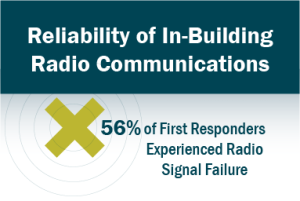
Source: Safer Buildings Coalition’s International Association of Fire Chiefs (IAFC) survey
Radio Coverage Challenges
Despite advances in cellular devices, two-way radio communications remain the primary method to establish command and maintain control throughout the confusion of a high-risk incident or disaster.
Radio signal interruption can occur for many reasons. Anyone who has driven through a tunnel or deep into an underground garage knows how radio frequency gets attenuated inside these highly conductive structures. Beyond the obvious concrete enclosures, several sources can potentially weaken, absorb or block radio frequency.
Obstructions to radio propagation can include:
- Fixed infrastructure made of concrete or metal, such as bridges, communications towers, water towers, bridges, refineries, or solar photovoltaic (PV) arrays
- Temporary equipment such as cranes and other construction equipment, shipping vessels, or landfills
- Newly constructed buildings that feature low-emissivity (Low-E) glass windows containing metal or metal oxide
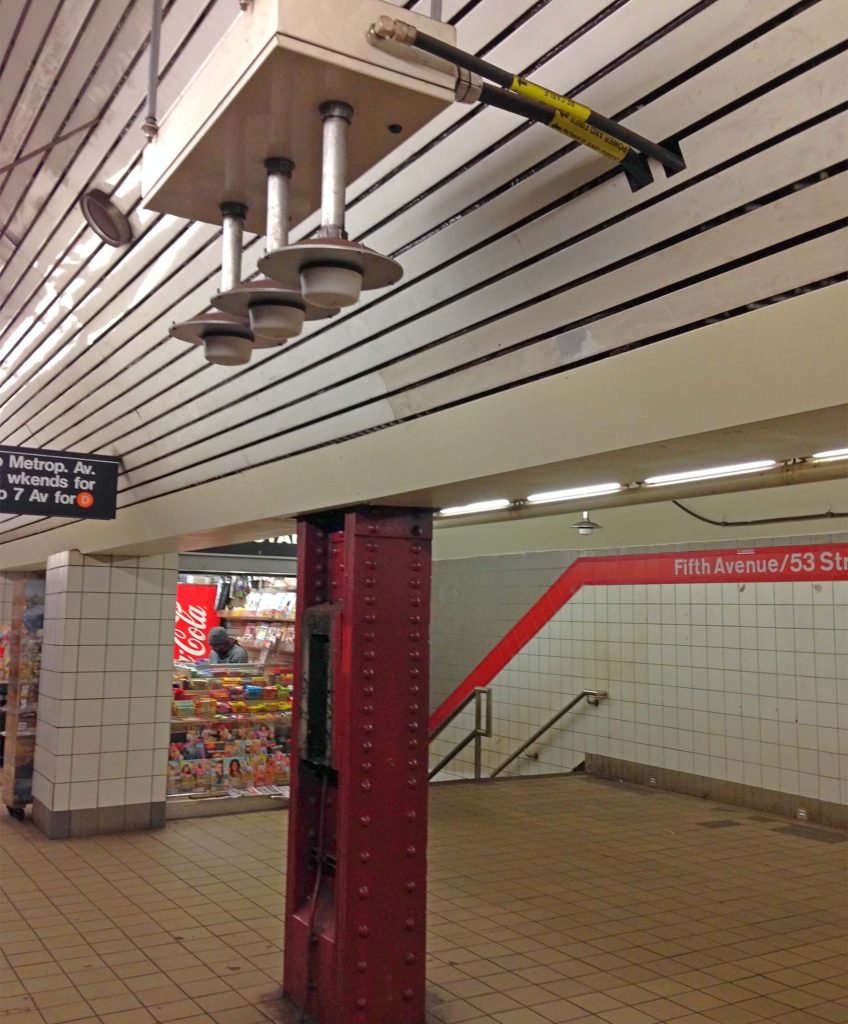
Antennas of Distributed Antenna System in New York City subway – Photo: Z22, CC BY-SA 3.0 via Wikimedia Commons
Low-E windows make buildings brighter, more energy efficient, and sustainable by blocking ultraviolet light and retaining conditioned air. Despite these benefits, the growing prevalence of high-performance buildings has created an unintended consequence, obstructing public safety radio signals that cannot penetrate through metal coatings.
Public facilities experience unique transmission challenges. Signal congestion and obstruction can often occur within high-trafficked areas such as stadiums or busy transportation hubs. Specially designed buildings — like airports or hospitals — oftentimes have many hard-to-reach spaces such as alcoves, stairwells, and elevators.
Growing Reliance on DAS
Over time, the U.S. Federal Communications Commission (FCC) has addressed concerns of radio interference by designating new bands exclusively for public safety purposes. Older emergency radio systems rely upon the ultra high frequency (UHF) or very high frequency (VHF) bands, while recently updated systems operate in the 7/800 MHz range.
A DAS connects a network of antennas to a common signal source to boost first responder agencies’ radio frequencies. DAS amplifies in-building wireless coverage to eliminate dead zones, enable clear voice transmissions, and enhance overall radio system performance.
When installing a DAS, operators generally choose between two system designs:
- Passive DAS relies on adequate signal from a nearby cell tower to broadcast between the building’s rooftop antenna to components such as coaxial cables, splitters and diplexers
- Active DAS converts signal using fiber-optic cables and a local power source. Due to higher costs, Active DAS is best suited for larger systems covering 200,000 square feet or more
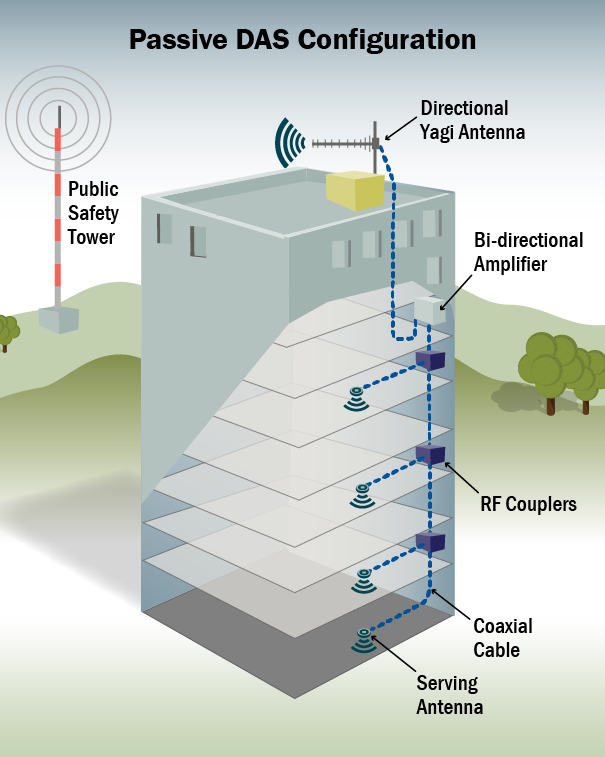
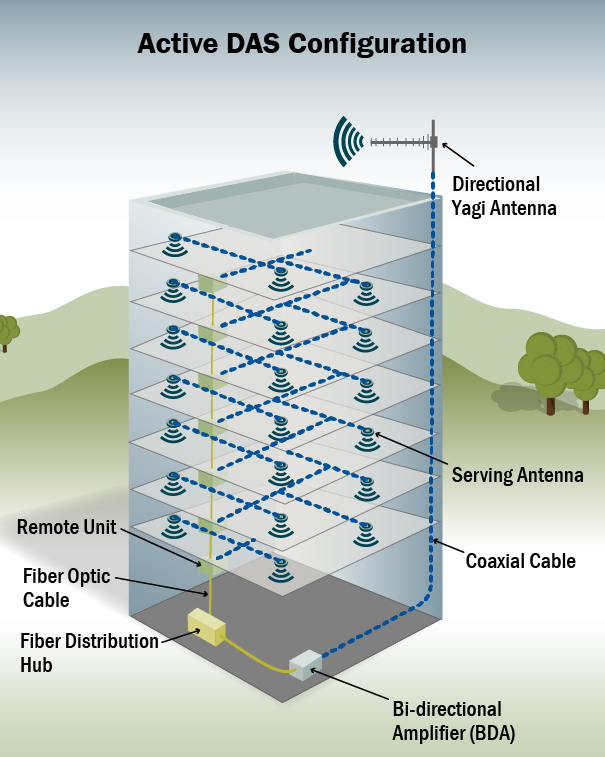
Life Safety Code Expands Radio Coverage Requirements
The National Fire Protection Association (NFPA) mandates that newly constructed buildings provide reliable and effective two-way radio communications systems. Specifically, NFPA 1221, Standard for the Installation, Maintenance and Use of Emergency Services Communications Systems sets requirements for radio coverage throughout structures spanning at least 50,000 square feet, any building more than two stories tall, and subterranean parking.
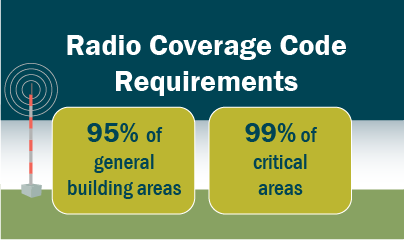
Source: NFPA 1225
Within buildings where two-way radio covered is required, code previously mandated coverage throughout 90 percent of the “general building areas” and 99 percent of the facility’s “critical areas,” including the:
- Fire command center and fire pump room
- Exit stairs and passageways
- Elevator lobbies
- Standpipe cabinets and sprinkler sectional valve locations
More recently, NFPA consolidated NFPA 1221 and the International Fire Code Section 510 into an updated NFPA Section 1225. Highlights of the 2022 edition include:
- Minimum radio coverage increased to 95 percent of the general building areas
- The definition of “critical areas” now include elevator shafts
- New battery storage and lighting protection system requirements
- Minimum delivered audio quality (DAQ) of 3.0 (on scale of 1-5)
Recognizing the importance of in-building radio coverage, many local authorities are incorporating public safety measures that go beyond code minimums. Recent examples include:
- New York City mandates DAS installation and maintenance for all new construction high-rise buildings, regardless of radio signal strength
- Florida has introduced requirements that any commercial or multi-family building project taller than 75 feet incorporate DAS into the facility’s design
- Several municipalities are preparing for NFPA 1225 by proactively expanding critical areas to include elevator shafts
AHJ Collaboration Is Essential
For new construction projects, public safety DAS is often the last system to be inspected. If a facility owner cannot demonstrate in-building radio coverage compliance, the Authority Having Jurisdiction (AHJ) will typically withhold issuing a Certificate of Occupancy. Early AHJ coordination is essential to ensure DAS installation compliance and to avoid costly delays.
Each AHJ takes a unique approach for how they oversee in-building radio coverage. Whether the responsible agency is the local fire chief, police department, or building inspection agency, the relevant agency will have their own preferred radio frequencies and own way of interpreting how to measure radio coverage. Waiting too long to identify and coordinate with the AHJ will likely add significant time and expense.
For example, early planning enables DAS conduit to be incorporated directly into a building’s concrete foundations. When projects wait until sitework is already underway, the conduit may need to be run through fire-rated drywall, driving up labor and material costs. If DAS installation takes place even later in the project, the only option may be to install two-hour rated coaxial cables at an even higher cost.
Close AHJ collaboration also enables design teams to better understand how code requirements will be enforced. NFPA 1225’s DAQ standard is highly subjective. Inspectors who have minor hearing loss may notice interference, while others consider the quality totally acceptable.
Facility owners and operators who need to expand in-building radio frequencies should turn to a qualified, licensed engineering team. DAS design partners should have experience in all necessary hardware and software, plus offer the capabilities to perform testing and commissioning.
With the right design strategy, DAS implementation can expand radio frequency using approaches that are cost effective, compliant, and — most importantly — support first responders’ safety communication needs.


